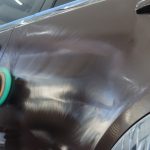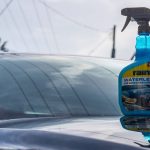In the world of automotive care, Rain-X stands out as a popular choice for those seeking improved visibility during inclement weather. Its water-repellent properties promise to keep windshields clear and drivers safe. However, as with any product, concerns and myths have emerged about the potential downsides of using Rain-X. In this comprehensive guide, we’ll explore the intricacies of Rain-X, separating fact from fiction to provide you with a well-rounded understanding of its impact on your windshield.
Understanding Rain-X
Rain-X is a hydrophobic solution designed to create a water-repellent coating on automotive glass surfaces. The product’s magic lies in its ability to alter the surface tension of water, causing it to bead up and roll off the windshield, improving visibility in wet conditions. It’s essential to recognize that Rain-X operates as a temporary solution, and its effectiveness may diminish over time.
The Myths Surrounding Rain-X
Myth 1: Permanent Damage
A prevalent misconception suggests that Rain-X can cause permanent damage to windshields. The truth is, when used according to the manufacturer’s instructions, Rain-X is not known to inflict lasting harm. However, issues can arise with misuse or prolonged application, and we’ll delve into these scenarios to provide a clear perspective.
Myth 2: Wiper Blade Incompatibility
Another concern revolves around the compatibility of Rain-X with windshield wiper blades. Some worry that the product may affect the performance of wipers, leading to streaks and reduced efficiency. We’ll explore the science behind this claim and offer guidance on maintaining optimal wiper performance.
The Science Behind Rain-X
To truly comprehend Rain-X’s impact, it’s crucial to delve into the science behind its formulation. The active ingredient in Rain-X, polydimethylsiloxane, forms a hydrophobic barrier on the glass. Understanding this chemistry empowers users to make informed decisions about its application and potential side effects.
Pros of Using Rain-X
Enhanced Visibility
One of Rain-X’s undeniable benefits is its contribution to enhanced visibility during adverse weather conditions. The water-repellent coating encourages raindrops to slide off the windshield, reducing the need for constant wiper usage.
Easy Application
Rain-X’s user-friendly application process allows drivers to take matters into their own hands. This convenience makes it an attractive option for those looking to improve windshield performance without a professional’s assistance.
UV Protection
Beyond its water-repellent properties, Rain-X offers a layer of ultraviolet (UV) protection for your windshield. This added benefit helps prevent sun damage and can contribute to the longevity of your vehicle’s glass.
Cons of Using Rain-X
Residue Buildup
While Rain-X enhances visibility, over time, it can leave behind a residue on the windshield. This residue may compromise clarity and necessitate thorough cleaning. We’ll explore effective methods for removing this buildup and maintaining a clear view.
Limited Durability
Rain-X’s effects are not permanent, and the hydrophobic coating diminishes with time and exposure to the elements. Regular reapplication is necessary to sustain its benefits, prompting users to consider the trade-off between improved visibility and ongoing maintenance.
Potential Side Effects
In rare cases, users have reported side effects such as streaking or hazing. Understanding these potential issues allows for proactive measures and ensures a positive Rain-X experience.
Addressing Common Concerns
Wiper Blade Compatibility
We’ll provide detailed insights into the compatibility of Rain-X with various wiper blade materials and types. Understanding the dynamics between Rain-X and wipers is crucial for maintaining an unobstructed view. (See Also: Can You Use All Purpose Cleaner on Car Interior? A Comprehensive Guide)
Removing Rain-X Residue
For those experiencing residue buildup, we’ll go beyond the basics and provide step-by-step instructions for thorough removal. Restoring your windshield’s clarity is achievable with the right approach and products.
Tips for Optimal Rain-X Use
Application Techniques
Mastering the art of Rain-X application is key to maximizing its benefits. We’ll share tips on achieving an even coating for optimal performance.
Maintenance Schedule
Developing a regular maintenance schedule ensures that your Rain-X-treated windshield consistently performs at its best. We’ll outline a practical timetable for reapplication and cleaning.
Expert Tips for Maximizing Rain-X Performance
When it comes to ensuring optimal performance from Rain-X on your windshield, a few expert tips can make all the difference. Let’s explore these recommendations to help you make the most of this popular water-repellent solution.
1. Proper Application Technique
Achieving an even and thorough application is crucial for Rain-X effectiveness. Clean your windshield meticulously before application, ensuring there are no remnants of dirt or other products. Apply Rain-X in a circular motion, and follow the product’s instructions for the best results.
2. Regular Maintenance Schedule
To sustain Rain-X benefits, establish a consistent maintenance schedule. Periodically clean your windshield with a mild glass cleaner and reapply Rain-X as recommended by the manufacturer. This routine ensures the hydrophobic coating remains at its peak, offering continuous water-repellent performance.
3. Mindful Wiper Blade Selection
Choose wiper blades compatible with Rain-X to enhance the overall effectiveness of the product. Silicone or graphite-coated blades tend to work well with Rain-X, providing a smooth and streak-free wiping experience.
4. Avoid Overapplication
While Rain-X is beneficial, using it excessively can lead to residue buildup. Follow the recommended application frequency to prevent any adverse effects on visibility. A little goes a long way when it comes to Rain-X.
5. Address Residue Promptly
If you notice residue on your windshield, don’t procrastinate in addressing it. Promptly clean the windshield using a recommended glass cleaner or a mixture of vinegar and water. This ensures a clear view and prevents long-term buildup.
6. Consider Windshield Condition
Evaluate the condition of your windshield before applying Rain-X. If your windshield has scratches or chips, it’s advisable to address these issues first. Rain-X won’t fix physical damage, and applying it to a damaged surface may exacerbate existing problems.
7. Test in Controlled Conditions
Before relying on Rain-X during heavy rain or adverse weather, perform a test in controlled conditions. Apply Rain-X and observe how water behaves on your windshield. This allows you to gauge its effectiveness and address any issues before facing inclement weather. (See Also: How to Fix Chrome Peeling Off Rims: Quick Solutions for a Sleek Finish)
8. Combine with Glass Sealants
For an extra layer of protection, consider combining Rain-X with a high-quality glass sealant. This duo can provide enhanced durability and water resistance, especially in areas with frequent rain or snow.
9. Avoid Using on Interior Glass
Rain-X is formulated for exterior glass surfaces. Avoid applying it to interior glass, as the hydrophobic properties are designed for water repellency and may not provide any benefits on the inside of your vehicle.
10. Monitor for Side Effects
Keep an eye out for potential side effects, such as streaking or hazing, especially after applying Rain-X. If you notice any issues, address them promptly to maintain optimal visibility.
By incorporating these expert tips into your Rain-X maintenance routine, you can ensure a clear and safer driving experience in various weather conditions.
FAQs: Clearing the Air on Rain-X and Windshield Care
Navigating the world of windshield care and Rain-X application can bring about numerous questions. Here, we address some frequently asked questions to provide clarity on the usage and impact of Rain-X on your windshield.
1. Is Rain-X Safe for All Windshields?
Yes, Rain-X is generally safe for all types of automotive glass. However, it’s essential to check your vehicle’s owner’s manual for any manufacturer-specific recommendations or restrictions.
2. How Often Should I Reapply Rain-X?
The frequency of Rain-X application depends on various factors, including weather conditions and your driving habits. As a general guideline, reapply Rain-X every few weeks or as indicated in the product instructions for optimal performance.
3. Can Rain-X Cause Streaking on Windshields?
In some cases, overapplication or improper application technique may lead to streaking. Follow the recommended application instructions, ensuring an even coating, and use a clean, soft cloth for application to minimize the risk of streaks.
4. Does Rain-X Work in Freezing Conditions?
Yes, Rain-X can be effective in freezing conditions. It helps prevent the accumulation of ice on the windshield and improves visibility. However, keep in mind that extreme cold may affect its performance, and regular reapplication may be necessary.
5. Can Rain-X Be Applied to Side Windows and Rear Windshields?
While Rain-X is commonly used on front windshields, it can also be applied to side windows and rear windshields to enhance visibility. Follow the same application guidelines for consistent results. (See Also: How to Get a Free Car Wash: Ultimate Tips for a Sparkling Ride)
6. Does Rain-X Affect the Performance of Wiper Blades?
When used correctly, Rain-X should not significantly impact the performance of wiper blades. In fact, it can enhance the efficiency of wipers by reducing the friction between the blades and the glass. Use compatible wiper blades for the best results.
7. Can Rain-X Be Used on Cracked or Chipped Windshields?
Rain-X is not a solution for repairing physical damage to windshields. If your windshield has cracks or chips, it’s advisable to address these issues separately before applying Rain-X.
8. How Do I Remove Rain-X Residue?
To remove Rain-X residue, clean the windshield with a mild glass cleaner or a vinegar and water solution. Use a soft, clean cloth or a microfiber towel to ensure thorough cleaning without causing scratches.
9. Does Rain-X Provide UV Protection?
Yes, Rain-X offers a layer of ultraviolet (UV) protection for your windshield. This additional benefit helps prevent sun damage and can contribute to the longevity of your vehicle’s glass.
10. Can I Apply Rain-X to Interior Glass Surfaces?
Rain-X is formulated for exterior glass surfaces. Avoid applying it to interior glass, as the hydrophobic properties are designed for water repellency and may not provide any benefits on the inside of your vehicle.
Feel free to explore these FAQs to gain a better understanding of Rain-X and make informed decisions for your windshield care routine.
Conclusion
Is Rain-X bad for your windshield? The answer lies in a nuanced understanding of its pros and cons. While it offers undeniable benefits in enhancing visibility, users must be aware of potential drawbacks. Armed with this knowledge, drivers can make informed decisions about incorporating Rain-X into their windshield maintenance routine.
In closing, remember that responsible use, periodic evaluation, and proper maintenance are key to maximizing the benefits of Rain-X without compromising the longevity and clarity of your windshield. Drive safely!



